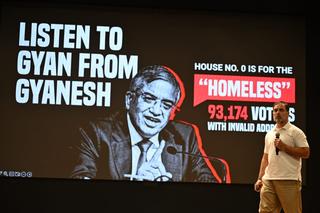The Congress party has announced a nationwide campaign to collect five crore signatures to highlight what it calls widespread “vote chori” — or electoral theft — across India. Led by MLC Manjunath Bhandary, the initiative seeks to mobilise public support, demand electoral transparency, and build political pressure ahead of upcoming regional and national polls. The exercise, the party says, is aimed at amplifying concerns over the legitimacy of recent electoral outcomes, which Congress alleges were influenced by opaque processes and institutional bias.
The campaign could also create new pathways for collaboration among political parties that oppose the ruling establishment. Though Congress has not formally sought other parties’ participation, analysts say the scale of the initiative leaves open the possibility of broader alliances. If regional parties see value in adding their own organisational heft, the movement may evolve into a multi-party pressure group. Such a development could reshape opposition dynamics, potentially forming a unified reform front. However, differences in ideology and regional focus may prevent seamless cooperation, making grassroots coordination a key testing ground for coalition feasibility.
Another anticipated outcome is the effect this campaign may have on younger political workers. Party insiders say mobilising students and first-time voters could give Congress a critical advantage, especially in constituencies where youth populations dominate electoral rolls. Street-level engagement may also help young volunteers gain firsthand experience in public mobilisation and democratic advocacy. Congress leaders believe this exposure could cultivate new leadership capable of communicating complex institutional issues with clarity. As India’s political landscape increasingly shifts toward youth-driven activism, this campaign may help the party groom future organisers and ideological custodians.
There is also conversation about how the data collected through the campaign might be used beyond symbolic submission. Large-scale signature records could reveal patterns of political interest and public opinion at a granular level. This could help Congress refine its policy messaging, identifying regions where concerns over electoral integrity resonate more deeply. The information might also guide resource allocation during campaign seasons, informing decisions on candidate selection, grassroots outreach, and communication strategy. Some observers, however, caution that such data must be handled responsibly to avoid accusations of political exploitation.
Despite its ambitious design, the campaign faces logistical barriers. Collecting such an enormous volume of signatures requires strong coordination, reliable tracking, and meticulous verification. Ensuring standardisation across states could also be difficult, particularly in linguistically diverse regions. Critics argue that large-scale drives risk inconsistencies that could undermine credibility. To counter this, Congress leaders are emphasising training and digital documentation, hoping to prevent duplication or manipulation. Whether ground-level execution can match strategic vision remains uncertain, but party officials say they are committed to transparency and organisational discipline throughout the exercise.
Ultimately, the signature drive underscores Congress’ attempt to recast its public image as a party capable of large-scale civic mobilisation. While challenges remain, the initiative signals a willingness to evolve beyond traditional campaigning and engage citizens through participatory channels. Whether the campaign results in institutional reform, electoral gains, or only symbolic momentum, it marks an important experiment in people-centred political advocacy. As the movement unfolds, its success will depend on sustained enthusiasm, organisational clarity, and the party’s ability to transform public sentiment into actionable political outcomes.
This mass push reflects a renewed attempt to energise grassroots workers and counter what party leaders describe as the diminishing trust in democratic institutions. According to Bhandary, Congress intends to not only gather signatures but also hold conversations with communities across states, launching booths and field drives to create awareness regarding voting rights. The campaign would culminate in the submission of the signatures to central authorities along with a request to reform electoral mechanisms in India.
Congress leaders say they aim to re-imagine public participation by directly involving citizens in a symbolic effort that underscores their constitutional rights. Political analysts view the initiative as both a mobilisation strategy and a narrative-shaping exercise, particularly important amid intensifying national debates over the impartiality of elected bodies. The effort, they believe, could significantly influence political alignments in the months ahead.
BIG NATIONAL PUSH
The drive is expected to be rolled out across every district, with party workers, supporters, student groups, and civil society members recruited as signature collectors. The campaign will also utilise door-to-door outreach to interact with households, particularly in rural segments where Congress believes voters were most affected by alleged electoral malpractice. Leaders assert that when combined with digital record-keeping, the activity could become one of the largest political signature campaigns in the country’s history.
Party representatives say the campaign is not only about contesting past results but also ensuring future elections occur in a fair atmosphere. According to insiders, leaders are preparing training modules, pamphlets, and messaging templates to ensure the campaign maintains narrative cohesion across states. The initiative will run for several weeks, after which the signatures will be compiled and presented to election authorities with a formal memorandum.
Congress claims that the electoral landscape has deteriorated due to reduced autonomy of institutions, administrative pressure, and misuse of state machinery. Bhandary reiterated that democracy must guarantee fair play, and only through people’s participation can systemic change be realised. This, he said, is why the party has chosen the language of signatures — to tangibly demonstrate public sentiment on the matter.
Political commentators suggest that the party has chosen a layered strategy to counter what it perceives as the dominance of the ruling party. The signature campaign will likely provide Congress with valuable data on regional engagement, public mood, and volunteer strength. These metrics could then be used for organisational restructuring and strategic planning in upcoming contests. Opposition parties are expected to observe the campaign closely, with some possibly considering similar public-centred initiatives.
Grassroots-level organisers expect high participation in Karnataka, Maharashtra, Rajasthan, and parts of South India, where Congress continues to retain strong local support. To ensure transparency, the party is planning to maintain digital tracking of sheets, verifying participation numbers. This may also help the party assess where further organisational strengthening may be required. Youth welfare departments within the party will assist in digital coordination, including uploading scanned entries.
GROWING POLITICAL SENTIMENT
Within Karnataka, Bhandary’s announcement has sparked renewed conversation around the party’s approach to national-level issues. With the state government already pushing welfare-focused schemes, the signature campaign is expected to reinforce Congress’ statewide visibility. Leaders believe this alignment will help build political continuity between local governance efforts and broader national debates, creating a consistent narrative bridge ahead of future elections.
Civil society organisations aligned with Congress ideology are expected to join the movement, helping facilitate public discussions on political representation. Some rights-based groups have welcomed the effort, stating that citizen-driven initiatives could lend weight to calls for greater electoral transparency. Critics, however, argue that the campaign could be primarily symbolic, achieving limited structural impact unless coupled with legal or institutional pushback.
Bhandary insisted that the campaign is meant to be an emotional democratic exercise — one that brings people’s voices together in a collective call for accountability. He emphasised that electoral reforms must be continuous, ensuring that India’s democracy remains vibrant and inclusive. Supporters believe this framing will resonate especially with first-time voters who seek fairness and institutional integrity.

Political experts say this mobilisation could be strategically harnessed by the party to deepen political empathy among voters. Emotional engagement, they note, is central to building momentum, and Congress appears intent on turning allegations of irregularities into a unifying cause. This could place pressure on ruling authorities to respond, even if the campaign’s immediate demands are not accepted.
The BJP and its allies are likely to dismiss the campaign as another political tactic, arguing that India’s electoral systems are secure and robust. Party insiders say counter-narratives may focus on past electoral outcomes favourable to Congress, aimed at discrediting accusations of systemic bias. This ongoing verbal clash is expected to fuel further political polarisation across states.
The signature drive could also strengthen internal party discipline. Bringing cadres onto a single mission could enhance coordination and improve communication between state-level units and national leadership. If executed successfully, the campaign may help the party identify emerging leaders, inspire on-ground participation, and foster renewed enthusiasm among its workers. Such outcomes may prove critical for Congress’ organisational revival.
At a broader level, the initiative reflects heightened political sentiment across India. As narratives of democratic erosion and institutional weakening dominate public debate, citizens increasingly seek to participate in governance discourse. Congress hopes to channel this sentiment toward electoral reform. The campaign’s scale signifies an attempt to translate public emotion into tangible political expression — a strategy with both symbolic and strategic implications.
Congress is also expected to integrate the campaign into a larger communication matrix involving social media, district-level town halls, campus interactions, and women-centric public meets. The party believes these channels will help bridge age and demographic divides. Some segments — particularly among women and marginalised communities — may engage deeply, driven by concerns over representation and access to fair administration.
Analysts believe the campaign could emerge as a platform for broader political conversations on democratic culture. The party may utilise the campaign to educate citizens about voting procedures, administrative reforms, and constitutional preparedness. This pedagogical approach could elevate the campaign beyond symbolic protest, transforming it into a civic education movement that empowers young voters.

The campaign’s timing is crucial. With political temperatures rising as the country edges toward future elections, the signature initiative may help Congress create a forward-facing narrative that underscores its role as a defender of electoral democracy. The success of the initiative, however, will depend on sustained participation, credible documentation, and consistent messaging. If achieved, the campaign could significantly influence political discourse nationwide.
Ultimately, the Congress party’s five-crore signature drive represents a fusion of strategy, emotional outreach, and collective mobilisation. Whether the campaign translates into tangible reform remains to be seen. Yet, by engaging citizens in a highly visible democratic exercise, Congress hopes to signal its commitment to electoral fairness — and position itself as the custodian of people’s democratic rights.
Follow: Karnataka Government
Also read: Home | Channel 6 Network – Latest News, Breaking Updates: Politics, Business, Tech & More

